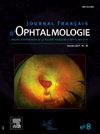Évaluation de l’épaisseur maculaire chez le sujet drépanocytaire homozygote SS à la tomographie par cohérence optique à Yaoundé
IF 1.2
4区 医学
Q3 OPHTHALMOLOGY
引用次数: 0
Abstract
Objectif
Le but de cette étude était de décrire les modifications maculaires observées grâce à la tomographie par cohérence optique chez les patients drépanocytaires homozygotes SS.
Méthodologie
Dans cette étude transversale, l’épaisseur maculaire de 42 patients (77 yeux) drépanocytaires SS a été comparée quadrant par quadrant à celle de 82 sujets (148 yeux) non drépanocytaires. Les mesures ont été faites grâce au SD-OCT 3D Maestro Topcon puis cartographiées sur les 9 quadrants de la grille maculaire établie par l’Early Treatment Diabetic Retinopathy Study. Les variables étudiées étaient : l’âge, le genre, le nombre de crises vaso-occlusives annuelles, le traitement prophylactique, l’acuité visuelle corrigée de loin et de près, la rétinopathie drépanocytaire, les épaisseurs maculaire moyenne, centrale (fovéolaire), temporale interne, nasale interne, supérieure interne, inférieure interne, supérieure externe, inférieure externe, nasale externe, temporale externe. Les différences étaient considérées comme statistiquement significatives pour les valeurs de p < 0,05.
Résultats
L’épaisseur maculaire moyenne était de 271,3 ± 20,9 μm chez les drépanocytaires homozygotes SS contre 272,4 ± 20,9 μm chez les patients non drépanocytaires (p = 0,891). L’épaisseur maculaire moyenne diminuait avec l’âge ; pour un an de plus, un amincissement maculaire de 0,72 μm était observé. Le taux d’amincissement maculaire central était de 40,26 %. Il existait un amincissement significatif chez les drépanocytaires dans les quadrants nasal externe (p = 0,05), temporal externe (p = 0,002) et inférieur interne (p = 0,02). Le nombre de crises vaso-occlusives était associé de manière non significative à ces amincissements.
Conclusion
La tomographie par cohérence optique pourrait contribuer à objectiver l’atteinte maculaire infraclinique chez le drépanocytaire homozygote SS.
Objective
To describe tomographic macular changes in homozygous SS sickle cell patients.
Methods
In this cross-sectional study, the macular thickness of 42 patients (77 eyes) with sickle cell SS was compared quadrant by quadrant with that of 82 subjects (148 eyes) without sickle cell disease. The measurements were performed using the Topcon Maestro SD-OCT 3D and then mapped onto the 9 quadrants of the macular grid established by the Early Treatment Diabetic Retinopathy Study. The studied variables were: age, gender, number of annual vaso-occlusive events; prophylactic treatment, visual acuity corrected for distance and near, sickle cell retinopathy; mean macular thickness, mean central (foveolar), and mean temporal inner, nasal inner, superior inner, inferior inner, superior outer, inferior outer, nasal outer, and temporal outer retinal thicknesses. The differences were considered statistically significant for P values < 0.05.
Results
Mean macular thickness was 271.3 ± 20.9 μm in homozygous SS sickle cell patients versus 272.4 ± 20.9 μm in non-sickle cell patients (P = 0.891). This decreases with age; for each year, the macula thins by 0.72 μm. The central macular thinning rate was 40.26%. There was significant thinning in sickle cell patients in the nasal outer (P = 0.05), temporal outer (P = 0.002) and inferior inner (P = 0.02) quadrants and non-significant thickening in the inferior outer quadrant. The number of vaso-occlusive events was not significantly associated with thinning of these parameters.
Conclusion
Optical coherence tomography has made it possible to objectify subclinical macular involvement in homozygous SS sickle cell disease.
用光学相干断层扫描法测定均合子镰状细胞病患者的黄斑厚度(Yaounde)
ObjectifLe。本研究的目的是描述所观察到的变化变性借助光学断层扫描一致性升高的患者中,纯合体SS.MéthodologieDans横这项研究,厚度maculaire 42(77名患者眼中,SS)升高了象限的象限的82名受试者相比未升高(148)的眼睛。测量是用SD-OCT 3D Maestro Topcon完成的,然后在耳朵治疗糖尿病视网膜病变研究建立的黄斑网格的9个象形图上绘制。反应变量是:年龄、性别、年度vaso-occlusives发作次数、预防治疗,视力矫正远和近、镰maculaire平均厚度、视网膜病变(fovéolaire颞叶)、中央内部鼻腔内部,下半更高强的内部、外部、内部、外部、鼻腔外部,外部的颞叶。这些差异被认为对p值具有统计学意义。0.05。结果:SS均合子镰状细胞患者平均黄斑厚度为271.3±20.9 μm,非镰状细胞患者平均黄斑厚度为272.4±20.9 μm (p = 0.891)。黄斑的平均厚度随着年龄的增长而减少;再过一年,黄斑变薄0.72 μm。中央黄斑衰减率为40.26%。鼻外象限(p = 0.05)、鼻外颞象限(p = 0.002)和鼻下象限(p = 0.02)镰状细胞显著减少。血管闭塞发作的数量与这些下降没有显著关联。结论:光学相干断层扫描可能有助于客观化同合性镰状细胞性镰状细胞病患者的基底黄斑病变。ObjectiveTo描述了同合性镰状细胞性镰状细胞患者的断层扫描黄斑变化。在这项横断面研究中,42例镰状细胞病患者(77只眼睛)的黄斑厚度与82例无镰状细胞病患者(148只眼睛)的黄斑厚度进行了比较。测量使用Topcon Maestro SD-OCT 3D进行,然后映射到早期治疗糖尿病视网膜病变研究建立的黄斑网格的9象素。研究的变量是:年龄、性别、每年闭塞血管事件的数量;预防治疗,视距离和近距离矫正视力,鳞状细胞视网膜病变;一种是指黄斑厚度,一种是指中央(foeolar),一种是指临时内、鼻内、上内、下内、上外、下外、鼻外和临时视网膜外厚度。P值的差异被认为具有统计学意义。0.05.结果:全合子SS镰状细胞患者黄斑厚度271.3±20.9 μm,非镰状细胞患者黄斑厚度272.4±20.9 μm (P = 0.891)。这种情况随着年龄的增长而减少;黄斑每年变薄0.72 μm。中央黄斑瘦率为40.26%。患者鼻腔外象限(P = 0.05)、颞外象限(P = 0.002)和下内象限(P = 0.02)有明显变薄,下外象限无明显变厚。血管闭塞事件的数量与这些参数的稀薄没有显著关联。结论光学相干断层扫描使我们有可能客观地确定亚临床黄斑参与同合性SS鳞状细胞病。
本文章由计算机程序翻译,如有差异,请以英文原文为准。
求助全文
约1分钟内获得全文
求助全文
来源期刊
CiteScore
1.10
自引率
8.30%
发文量
317
审稿时长
49 days
期刊介绍:
The Journal français d''ophtalmologie, official publication of the French Society of Ophthalmology, serves the French Speaking Community by publishing excellent research articles, communications of the French Society of Ophthalmology, in-depth reviews, position papers, letters received by the editor and a rich image bank in each issue. The scientific quality is guaranteed through unbiased peer-review, and the journal is member of the Committee of Publication Ethics (COPE). The editors strongly discourage editorial misconduct and in particular if duplicative text from published sources is identified without proper citation, the submission will not be considered for peer review and returned to the authors or immediately rejected.

 求助内容:
求助内容: 应助结果提醒方式:
应助结果提醒方式:


